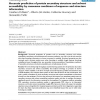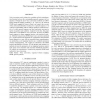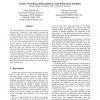1074 search results - page 144 / 215 » Alignment of Non-Overlapping Sequences |
ISMB
1994
13 years 11 months ago
1994
Wepresent the prototype of a software system, cMledGeneQuiz,for large-scale biological sequence analysis. The system was designed to meet the needs that arise in computational seq...
BMCBI
2004
13 years 9 months ago
2004
Background: It is a major challenge of computational biology to provide a comprehensive functional classification of all known proteins. Most existing methods seek recurrent patte...
BMCBI
2007
13 years 10 months ago
2007
Background: Structural properties of proteins such as secondary structure and solvent accessibility contribute to three-dimensional structure prediction, not only in the ab initio...
ICASSP
2010
IEEE
13 years 10 months ago
2010
IEEE
Voice conversion can be reduced to a problem to find a transformation function between the corresponding speech sequences of two speakers. Perhaps the most voice conversions meth...
FGR
2000
IEEE
14 years 2 months ago
2000
IEEE
This paper proposes a state based approach to gesture learning and recognition. Using spatial clustering and temporal alignment, each gesture is defined to be an ordered sequence ...



